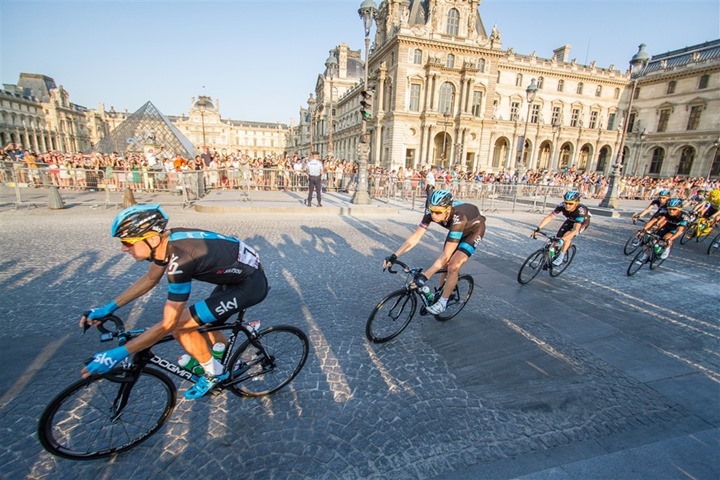
Today, another sports technology company joined in the roughly two week long fiesta of companies sponsoring pro cycling teams. Wahoo’s announcement this morning that they’re sponsoring Team Sky, makes Sky the epicenter of connected sports technology sponsorships: Stages power meters, Wahoo KICKR’s, and Training Peaks to round it up. But, there are other notable deals out there as well that are worthy of mention for a variety of reasons.
Of course, much of the attention over the last seven days has been on the Stages relationship with Team Sky. As you might figure, I’ve been flooded with questions on my thoughts about it. Thus, I thought I’d round up all the major sports-technology focused announcements leading up to the Tour Down Under, and give a few thoughts on them.
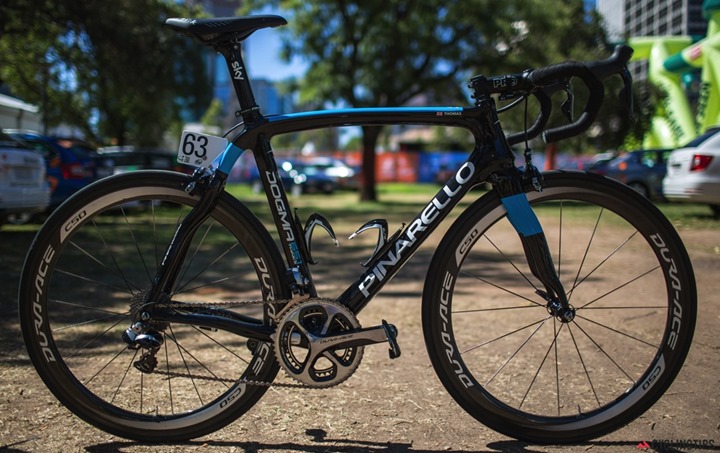
(Above image reproduced with permission from Cycling Tips)
The importance of last week’s sponsorship with Team Sky by Stages Cycling cannot be overstated – not from a technical standpoint, but from a sales standpoint. In having what is the most visible and elite Pro Cycling team out there displace ‘the gold standard’ power meter – SRM – for a power meter 1/4th the price, it sends a message that’s hard for any other power meter company to argue.
But, it’s probably first important to take a step back and acknowledge the basic principal of sponsorships: It’s a business deal where one company pays another individual or entity for publicity reasons. What that ‘payment’ is can vary. For age group athletes it may be discounted or free gear. For non-celebrity elite/pro athletes, it may be free gear and bonus checks tied to podium placements. And for highly visible pro athletes and teams it’s usually a straight annual check along with additional bonuses for certain achievements. Kinda like a Strava KOM, except with cold hard cash.
Grand tour level Pro Cycling teams cost millions of dollars each year to fund and operate, this post does a great job at looking into that. Each team has a multitude of sponsors, typically the biggest of which is the team name sponsor. In Sky’s case, that’s simply Sky Sports (a UK TV entity). Just like in Team Garmin Sharp’s case, it’s Garmin (GPS maker) & Sharp (consumer electronics company). Under the covers, Team Garmin is really Slipstream sports, and based in Boulder, Colorado.
Beyond the initial sponsor, there are a hierarchy of sponsors. Usually big name companies, including the bike brand. Below, the lineup of companies off of Sky’s site (not quite yet updated). As you can see, it currently shows ‘Elite’ (trainers). I suspect that’ll probably change by the end of the day. [Update: After hearing from Elite, they’ll continue to be a sponsor for water bottles and water bottle cages.]

With that in mind, you turn to Stages Cycling, and their $699 power meter. When it was introduced a little over a year ago, it made quite the splash – primarily for its price. After sorting out some initial technical teething pains, they’ve continued to find strong demand. Placing an order today results in a waitlist spot, and they’ve since expanded into Europe and Australia/New Zealand.
Of course, as anyone who’s looked at the Stages power meter knows, it has one significant limitation: It only measures a single leg: your left leg. As such, if you’re not balanced you’ll see potential variation in that end power number. In my Stages review I found that for me in the majority of my riding cases, it didn’t impact me significantly. However, there is still a dependence on equality of my legs at all power levels and situations.
Fast forward to this fall and I published my Garmin Vector review, which contained data from four concurrent power meters – Garmin Vector, PowerTap, SRAM Quarq ELSA, and the Stages Power Meter. Within that, astute readers starting dissecting not just the Vector data, but the accompanying data. As they were able to start plotting the Vector left/right data against the Stages data some interesting trends came out of that.
For example, as a triathlete I tend to be fairly steady state in my training. I rarely go about my FTP level (about 315w) for any length of time. I simply don’t have any need to do a finish sprint in the cycling leg of a triathlon. But, as you started looking at my data, people found that the further I went beyond FTP, the less balanced my legs became. Thereby, the more impactful it could be in a Stages situation (in that case, under-reporting). As more people have used Vector, they’ve started to find other trends. Those trends vary by person, situation, and ride. From fresh to fatigue, and from easy to hard.
But why is all this important?
Well, Team Sky has noted numerous times that they are a team of ‘marginal gains’. Meaning that they (by their own admission) focus on getting that last watt out of each effort as a means for reaching the pinnacle of the sport. As such, switching to a power meter that factually doesn’t potentially capture all power output (by Stages own admission) is certainly a head scratcher.
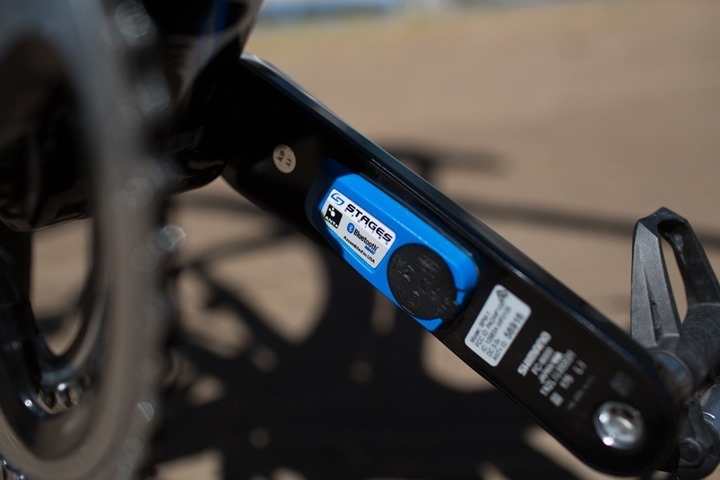
(Above image reproduced with permission from Cycling Tips)
Which, ultimately brings two potential reasons: First, Stages simply paid enough to Sky to solve the problem. After all, almost every entity has ‘a price’. For Stages, that price would likely be the best ever marketing money they’ve spent. If it were me in their shoes, I’d easily be able to justify an expense upwards of a million dollars to still have a positive return on investment (ROI). One only need to look at the forum postings and new article comment postings since then, which all roughly echo “If it’s good enough for Wiggins and Froome, it’s good enough for me.” There’s no real elevator-pitch length comeback that SRM has for that.
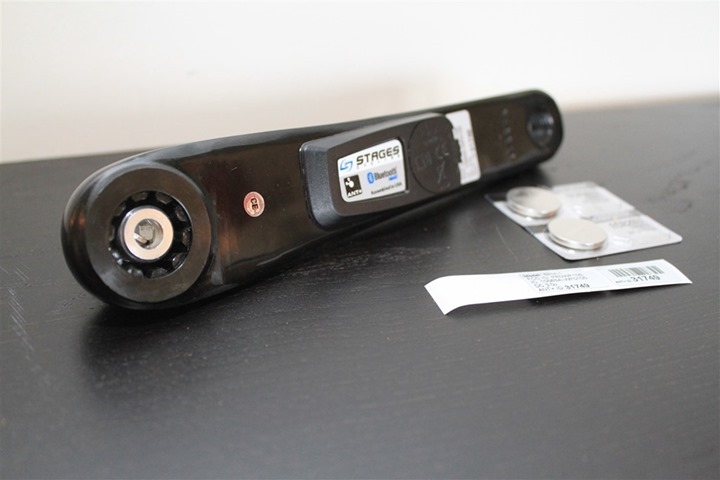
The second possibility is that Stages is working on a full left/right power meter, utilizing two pods. This would be an interesting move for the company, which has stated multiple times in the past that while they have looked at that scenario, they found a number of technological and financial hurdles there. From the standpoint of placing the pods on the secondary (right) crank arm, the issue is that frames vary significantly, and in that region there’s potential issues with clearing the chain-rings, derailleur and chain. An issue that their rival Garmin has seen with their Vector system not fitting on all bikes. Further, Stages has noted in the past that the cost would still be a case, as the price for ‘completing’ the right side of the drive-train is higher, since that would involve attaching (permanently) the sensor pod to not only the crank arm, but also the spider. Simply put, it’s more expense.
This is all in line with Stages past comments in press situations where they’ve said they don’t believe there’s a need for another $1,500-$2,000 power meter. Thus, I’m skeptical that they’d put forth a product in that price range. Especially as more and more companies jump into the field (and do so at a higher price point).
However, if Stages were to come out with a product, they’d have to do so relatively quickly to take advantage of the visibility that Sky would bring. The pinnacle event of the year is clearly the Tour de France. But there’s a multitude of spring events that are key headliners in the cycling world with immense visibility. The challenge is that pro cycling teams generally dislike changing gear too far into the season, thus putting a potential new full left/right model of a unit on the team in say, June, seems highly unlikely.
Thus, either Stages plans release of a product in the timeframe of ‘soon’, or Stages simply paid money enough that Sky was willing to overlook their ‘marginal gains’ requirement. It’s as simple as that.
Now, I do want to point out one important thing: At the end of the day, this sponsorship will increase visibility of power meters within the sport. And that, I believe is a good thing – regardless of which product a person ends up choosing.
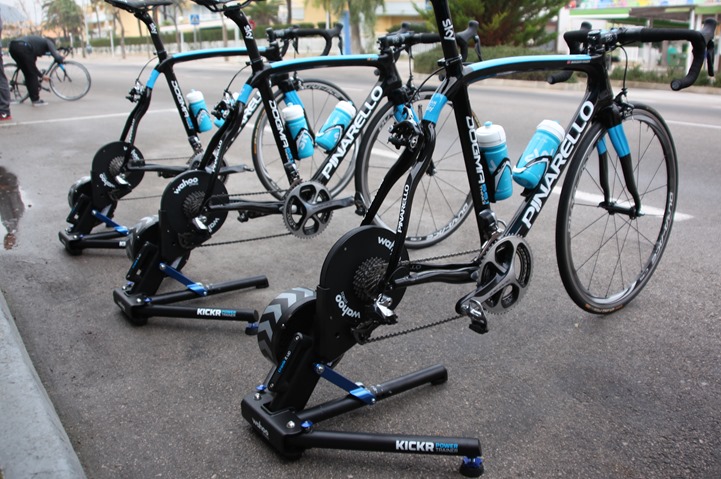
Next up, another Team Sky sponsorship deal – this one for trainers from Wahoo Fitness. Wahoo will become the official sponsor of “turbo trainers” for the team.
As part of that, the Wahoo will be providing Wahoo KICKR’s for each rider at home, as well as at the team training facility. Additionally, the team will conduct all pre-race warm-up and warm-down workouts on the KICKR. On a related note, some of you may remember from last year when the warm-up/warm-down procedure was posted here.
Wahoo will be replacing previous trainer company Elite, who sponsored the team last year.
From Wahoo’s standpoint, I’d put this in the category of “a good deal”, but not anywhere in the same league as Stage’s “mind-bogglingly good deal”. At present, Wahoo is pretty much leading the scene from a hardware standpoint when it comes to the high end trainer market. Their biggest competitor if you look at pro-level athletes is really CompuTrainer, mostly due to years of brand recognition – not because of technology innovation. But the CompuTrainer is rarely seen outside of pro team buses, mostly due to the complexity in setting it up in such an environment (it’s more often found in training facilities).
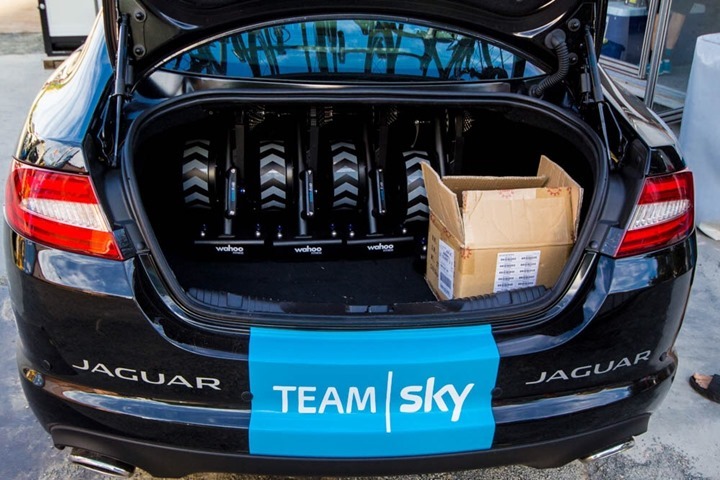
I was curious about Team Sky’s plans for how they’ll connect power to the trainers next to the team bus (as the KICKR requires a tiny bit of power to function). The answer was pretty simplistic: A 12V battery akin to a motorcycle battery. The setup allows them to make it fairly portable (at least as portable as a 45lb trainer is going to be). Wahoo noted that they’re going to tidy things up though and make this solution also consumer-available as well.

![clip_image001[5] clip_image001[5]](https://media.dcrainmaker.com/images/2014/01/clip_image0015_thumb.jpg)
When it comes to head units, Team Sky posted to their Facebook page that they’ll be using Garmin Edge 500’s and 810’s, which have been re-branded with the Stages logo:

The Edge 500/810 works with the Wahoo KICKR today, reading in speed and power information. In order to control the Wahoo KICKR though, they’ll need a separate device – such as a phone or iPad. Then again, we might just see a bit of a firmware update to said Edge units to allow them to control the KICKR via ANT+. Sometimes ya never know what the winds of Olathe will bring.

(Above image reproduced with permission from Cycling Tips)
Out of all the most obvious sponsorships out there, the CycleOps and Trek connection is likely driven through their Madison, Wisconsin shared roots. You can see a bit of that Madison action from my tour into the Saris/CycleOps trainer factory back this fall.
While the sponsorship here is probably less groundbreaking than some of the others simply due to the products being used, it’s definitely worthwhile noting.
For pre-race warm-up and cool-downs, the team will be using the CycleOps SuperMagneto Pro trainers. In addition, certain “key members” of the team will also receive the new CycleOps Silencer and PowerBeam Pro trainers. The PowerBeam Pro is CycleOp’s high-end trainer that competes with the Wahoo KICKR. Last year, Trek ran on TACX trainers.
In addition, the team will also be using the Virtual Training software suite to do ride-through’s of upcoming events, using the virtual reality functionality.
Team Garmin & Garmin Vector:

(Above image reproduced with permission from Cycling Tips)
Next, there’s some minor (albeit expected) news coming out of the Team Garmin camp. Namely that they’ve started to use Garmin’s power meter – Vector – on the pro team bikes. This was expected, as I noted way back in August when Garmin confirmed that the team would be using them from their December training camp onwards. We’ve now seen a few races in the last week with various team members having them installed and using them now in races. This is a shift from last year, when they just used empty pedal bodies with the Garmin branding on them (but no Vector pods).
Now, what’s actually interesting here is that this will start to provide us (the geeky general public) with the first look at pro-level data with true left/right power numbers. Up until this point, such data simply wasn’t available since almost nobody in the pro peloton was using a left/right power meter and actually publishing said data. There have been a few people running with the Polar/Look power system in the past, but I haven’t seen considerable data come out of that.
Garmin has historically provided some random data sets and published them to their Garmin Connect platform. Though, they haven’t always put that all in one place, so it’s kinda splattered about different accounts a fair bit.
Team Lampre Merida & ROTOR Power:

(Above image reproduced with permission from Cycling Tips)
Last but not least we have Team Lampre Merida announcing that ROTOR will be sponsoring them with the ROTOR Power System, which is ROTOR’s full left/right capable power meter that came out last year. This was announced the first week of January. Previously, Team Lampre was sponsored by SRM for power meters.
In talking with ROTOR, the team will start phasing it in over the next month or so, as they move to some of their February training camps. This explains why it’s not quite fully visible yet on bikes within the Tour Down Under.
This will be interesting on the same level as the Garmin Vector data, as this data will also start to more clearly illuminate what the pro scene looks like from a left/right balance perspective. This is because the ROTOR Power System independently measures both sides of the crank.
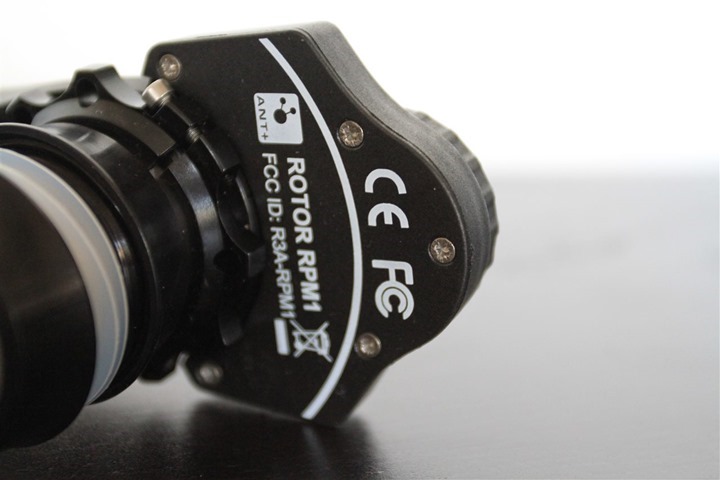
In talking with ROTOR, they are working with the various teams (above, and below) to get snippets of that data published. The exact details of which platforms they’ll upload to are being worked out.
Further, of note is that ROTOR is and will be equipping the following 2014 teams with ROTOR Power Systems: Jelly Belly Team within the US, Specialized Foundation Alberto Contador Junior & U23 teams, about half of the Caja Rural riders (individual deals), and then La Pomme Marseille (in France). On the individual pro triathlete site you’ll see Fred Van Lierde, Mary Beth Ellis, and a few others.
![ultimate-cf-slx-9_teambike_neu_thumb[6] ultimate-cf-slx-9_teambike_neu_thumb[6]](https://media.dcrainmaker.com/images/2014/01/ultimate-cf-slx-9_teambike_neu_thumb6_thumb.jpg)
(Added January 22nd, 8AM CET)
Today, pro cycling team Movistar announced that they’ll be using Power2Max Type S power meters for all their training and racing in 2014. The units will be running a new Power2Max Type S variant that was developed for Campagnolo 11-speed cranks. This new variant will be used by the team in both 135 and 100 BCD’s.
Like a number of the other companies noted here, Power2Max has sponsored individual athletes with their power meter in the past but this is the first time the company has jumped over to sponsoring a full UCI pro team. It’s also a pretty significant jump in the spotlight by any standard, with Movistar consistently one of the top contenders on the world circuit.
![TYPE_S_110_COMPAGNOLO_KETTENBLATT_rgb_thumb[5] TYPE_S_110_COMPAGNOLO_KETTENBLATT_rgb_thumb[5]](https://media.dcrainmaker.com/images/2014/01/TYPE_S_110_COMPAGNOLO_KETTENBLATT_rgb_thumb5_thumb.jpg)
![TYPE_S_135_COMPAGNOLO_KETTENBLATT_rgb_thumb[10] TYPE_S_135_COMPAGNOLO_KETTENBLATT_rgb_thumb[10]](https://media.dcrainmaker.com/images/2014/01/TYPE_S_135_COMPAGNOLO_KETTENBLATT_rgb_thumb10_thumb.jpg)
Also like many of the other sponsorship changes, the change by Movistar will come at the expense of SRM, who previously sponsored the team in past seasons.
From Power2Max’s standpoint, I would say that the sponsorship is definitely a worthwhile deal. Though, at the same time – Power2Max already has a pretty good brand and stability reputation – so they weren’t trying to ‘convince’ people at this point. Instead, the move would likely be more about brand awareness. The company doesn’t have as great of market penetration as some of the other brands with wider distribution and marketing channels.
While the company did experience some earlier product teething issues, they were resolved about 15 months ago with the second generation units that included temperature compensation. And from my testing as part of my in-depth review, these newer units have been very stable and reliable. As we move later into the spring, expect to see a Type S review from me as well, updating what I last reviewed from them in the previous release.
Finally, some might see the shifts of all these teams away from SRM as a ‘trend’. Honestly, I don’t see it that way. I simply see it as a case where business entities are making business deals. Given the size of SRM, they likely could not continue to sponsor as many pro teams if/when the price of sponsorship is raised based on additional companies making sponsorship offers.
—
With that, thanks for reading!
FOUND THIS POST USEFUL? SUPPORT THE SITE!
Hopefully, you found this post useful. The website is really a labor of love, so please consider becoming a DC RAINMAKER Supporter. This gets you an ad-free experience, and access to our (mostly) bi-monthly behind-the-scenes video series of “Shed Talkin’”.
Support DCRainMaker - Shop on Amazon
Otherwise, perhaps consider using the below link if shopping on Amazon. As an Amazon Associate, I earn from qualifying purchases. It doesn’t cost you anything extra, but your purchases help support this website a lot. It could simply be buying toilet paper, or this pizza oven we use and love.
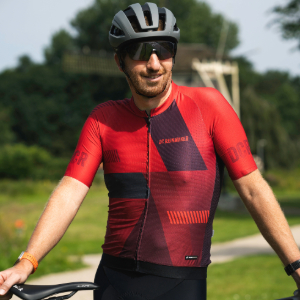















![clip_image001[5] clip_image001[5]](https://media.dcrainmaker.com/images/2014/01/clip_image0015_thumb.jpg)





![ultimate-cf-slx-9_teambike_neu_thumb[6] ultimate-cf-slx-9_teambike_neu_thumb[6]](https://media.dcrainmaker.com/images/2014/01/ultimate-cf-slx-9_teambike_neu_thumb6_thumb.jpg)
![TYPE_S_110_COMPAGNOLO_KETTENBLATT_rgb_thumb[5] TYPE_S_110_COMPAGNOLO_KETTENBLATT_rgb_thumb[5]](https://media.dcrainmaker.com/images/2014/01/TYPE_S_110_COMPAGNOLO_KETTENBLATT_rgb_thumb5_thumb.jpg)
![TYPE_S_135_COMPAGNOLO_KETTENBLATT_rgb_thumb[10] TYPE_S_135_COMPAGNOLO_KETTENBLATT_rgb_thumb[10]](https://media.dcrainmaker.com/images/2014/01/TYPE_S_135_COMPAGNOLO_KETTENBLATT_rgb_thumb10_thumb.jpg)













Thanks Ray. Another timely post… :-)
Trek’s signing with CycleOps is only for trainers then?
It appears that Trek is outfitted with an SRM. Boy would it be exciting if Pro teams used CycleOps power meters. There would be a revolution in power meters between Trek and Sky that could possibly benefit the rest of us.
Correct, trainers only for CycleOps.
Interesting that Garmin would agree to brand its 500/810 (or is it the newer 510?) head units with the Stages nameplate — at least for Team Sky. Kinda sends mixed message, at least from Garmin’s perspective, no?
This was after-market, so once they buy units they can do whatever they want to them. And yes, it was the Edge 500 (smaller), not the Edge 510.
Not to be cynical, but maybe Stages’ contract with Sky doesn’t cover training, thus allowing Sky to use other power meters for training, leaving the Stages PM for racing and media events. Of course it’s also possible that Sky does testing on some other system, thinking that there’s as yet little merit to L/R readings on the road.
No matter what, it was a surprising choice by Sky.
No, that’s incorrect. I just confirmed with the Stages folks on this, their response regarding what the sponsorship covers:
“Training and racing for the entire team, no exclusions. There is a transition period going on now, where as we’re outfitting the team in steps, but by the end of February there should be nothing but Stages meters in the team’s livery.”
Thanks for checking.
What about Pioneer and Belkin, is that an old story…?
Yeah, that was a 2013 introduction.
Ok thanks, then nevermind :)
Looking at the performances and careers of top Sky riders in any sort of detail leads to the almost certainty that one of their “marginal gains” is doping. The weight loss, massive rider improvements season-to-season, W/Kg numbers, performance comparison against convicted dopers on popular Tour/Giro climbs, lack of transparency from management, their sketchy hiring practices, and the BS notion that they’re the only team that are chasing detailed performance improvements… it all points the finger at doping. The Stages announcement just flies in the face of all of it. Cycling still lives deep in the era of doping.
It’ll all come out in the wash.
My gut feeling is they’re doing something that might not be illegal currently but might be made so if it came out.
Do some more research. It will come out in the wash but in the mean time they’re continuing to help ruin cycling and playing fans for fools.
Hey all-
As much as I ‘enjoy’ debates/discussions about cycling and doping, let’s try and keep things focused on sports technology (exclusive of doping) for this post. Sound good?
Thanks!
-Ray
(Mostly trying to keep this from spiraling)
Hi,
I’m sorry Ray. But that has got everyting to do with it. I still don’t understand that in a sport where basicly noting has changed. Sporting brands don’t uderstand that there tools had noting to do with the marginal gains. :-) Which can explode in their face.
Back to Stages. Seen the European prices? I think they are a bit off. For the same price you can almost buy a complete crank with power2max. (Which has left/right balance etc etc.) I personally don’t like these sponsor activities. I don’t want to pay the sponsorshipfees, just want to have a good product for a fair price.
BTW: Is there any knowlegde about Stages availability for Rotor cranks?
BTW2: I’ll keep all my hopes on Brimm Brothers. But they’re taking ages to get their product done. :-)
Yeah, the Stages Euro prices are a bit higher. And I agree with you, that P2M is more compelling when you get in that range.
Ultimately, professional sports don’t work without sponsorship’s. There’s no two ways about it. Either companies sponsor, or there is no professional sports scene.
On Stages + ROTOR, it’s definitely a ROTOR issue right now. Stages would be thrilled to support it. Obviously, ROTOR less so.
As for Brim, I’m optimistic there….
I can add a few bits to this article Ray…
Sky are loving the Stages system, they are running left side only as intended. A few riders are throwing in muddled numbers so they are using SRM on the right side to see what this could be but its a very small number. Stages respond to software requests, they are constantly updating the Firmware and I would expect to see this help out the general public too. They are also supplying large numbers of devices vs SRM who are frankly useless at customer service and only provide 2 units per rider.
Training and racing is being done on stages and this morning it looked like they had changed out the riders at the TDU as well. Couldnt see the SRM’s on TV.
Stages provided the head units, hence they were re sprayed… they did the work not Garmin
So fundamentally Sky build a system around the bike which meets the marginal gains idea, ok so SRM is more accurate on the face of it. However the benefits of stages outweigh the loss of the accuracy.
Its lighter, it has more development going on, the company responds and works with them, they can have one on every bike, its easier for the mechanic to fit, they dont need magnets, the GPS works for mapping in the garmin so they can route remotely, the batteries last longer and are easier to change, etc, etc…
All these things add up to a better package than ultimate accuracy…
Having spent a weekend with them in Mallorca I learnt quite a lot about the way the team look at working. It actually makes a lot of sense. They don’t look at everything having a marginal gain, they look at the package providing a marginal gain.
Just because it’s used by a Pro Team doesn’t mean it’s the best solution. Seems like a sponsorship deal to me too. Remember when Footon Servetto used iBikes for a while?
Didn’t seem like just a Pro deal to me, big bucks to pay for a small company if they wanted to get them off SRM don’t you think??
Ray,
You comment about Stages PM, that “it has one significant limitation: It only measures a single leg: your left leg.” This ignores the fact that the BIGGEST drawback of Stages is that it cannot be used with carbon crankarms.
This means no Specialized, SRAM, Campagnolo, FSA, etc., etc.
At the pro ranks, this is a big deal, as there are still a few teams riding Specialized, SRAM and Campy.
Also, on a slightly related note, what is the expected date of release for the updated Garmin pedal pods, to accommodate thicker crank arms?
But Sky and many others are Shimano based, so there is no need for a Carbon crank.
Mass market, maybe, but for those who use Alloy its fine.
I find it pretty hard to believe that Sky riders would willingly move to a less accurate platform. With enough time spent using SRM and stages as the same time, one could learn how the data generally compare and contrast, ultimately allowing for consistency and confidence in the data – but this would be extremely frustrating. And think about the consequences if you’re wrong? I’m imagining Froome attacking and cracking on Ventoux (or similar). I wouldn’t be surprised at all to see them running dual systems with the Stages just there for show. The weight comment is a red herring since the UCI has not removed the 6.8kg limit at this point. Even though Pinarello frames tend to be quite heavy, there’s still room for the balast provided by a heavy (or a second) power meter in the 6.8kg limit. Stages must have paid a steep price for entry into team Sky – but good for them! Smart move for sure.
I’d be pretty sure they are not racing to power… they may train to power, but I doubt they Race it!
They may have an eye on NP but I cant see them chasing numbers all day whilst out in the tour. Surely most of the data is for post/training analysis and monitoring how the body is coping.
To that I can only provide this link (which happens to be quite entertaining in its own right).
link to chrisfroomelookingatstems.tumblr.com
I am very skeptical that Sky would be willing to train on Left-only power, as any rider trying to optimize their pedalling for maximum power reading and minimum effort is going to introduce a left-leg bias. Racing is of course a different thing.
I could believe that Sky are OK with Left-only power measurement, if they know what each rider’s power balance is likely to be at each power level, as during riding they can then adjust each LL power number according to their current balance, and after riding they can presumably run the power file through an algorithm that corrects it. I assume the Garmin units don’t have custom firmware to do this on the fly.
Their main challenge, therefore, is obtaining typical L/R balance information. Could the Wahoo units be the missing link? Wahoo can read data from Stages, could it use the Stages L power together with its own combined power measurement to add a power balance number to the data feed it is producing?
The challenge being that from what I’ve seen, fatigue plays a factor in left/right balance, thus even if predictive at given power thresholds – it’s still potentially a factor.
As for linking to Wahoo – that definitely could be done. Though, that adds a pretty hefty layer of complexity in data processing and just simple logistics.
Wouldn’t any imbalance testing and work to fix generally be done on the trainer so the limitation of stages wouldn’t matter much?
Linking to Wahoo shouldn’t be too hard as its not a problem for the trainer to solve as the trainer shouldn’t care about stages. Its a problem for the software they pair to the trainer and the power meter. That software can take the data from the trainer and the power meter and compare it with way more computing power to do something with that data.
The data simply has too many variables to do predictive – which is pretty much why Stages ultimately just doubles it.
For example, I’ve found the following items can impact my balance (others have found similar): Standing vs sitting, 15min into a ride vs 3hrs (fatigue), trainer vs road (really interesting), % of FTP (i.e. low wattage vs higher wattage).
Now again, to what degree each person cares about that data is a totally different item. And, to what impact it has to their training and racing.
So was is the is big new technology breakthrough that Stages hinted at in December on Twitter? I still haven’t seen anything. Unless they were talking about Team Sky, which doesn’t seem like a breakthrough in their devices to me.
Just as a minor update/FYI to the original post regarding the switch from Elite trainers to Wahoo trainers for Team Sky: After hearing from Elite, they’ll continue to be a sponsor for water bottles and water bottle cages.
Will Team Garmin be using the stock Exustar pedal or have they figured a way of mounting a better one?
Their using the standard Garmin Vector product, which is built on the Exustar pedal.
Large part of this is that no one has the data on Left/Right split meaning anything at all… Yet.
And sky have only ever had single sided power anyway, you are all jumping on this like they had the split before. They only had total power… as far as I am aware the SRM is like a powertap etc. It measures both sides but doesn’t break them down!
No, this has nothing to do with reading Left/Right power.
Stages explicitly only reports left power doubled. Thus, if you are unbalanced, then Stages will report either high or low based on balance.
Hi Ray, I get how the stages works and running Vector myself I have also seen the imbalances.
what I am trying to get across is that although the SRM gave total power, it has no split. this means they cant see any fatigue etc with SRM. Although the Stages doubles up, as long as it does it reliably and consistently that is more important for them.
I spent last weekend with them at their training camp and my main interest was the switch to Stages and only left power. They have some very good reasons for the switch!
Any chance you can get Wahoo fitness to hurry up with RKFLT+ integration for Android.
I though Stages was supposed to release their bb30 FSA power meter first week in January…I’d like to know where that is
They just did, check their website.
I can understand the teams not releasing the data of the riders during the season or even within the next few years (guessing same tricks the use this year they will continue to use if they work) but do you know if any plan to save all the data for some future release?
As someone who has waited months for my stages powermeters, I can only cringe when I think of how long the wait will be once their new relationship/sponsorship becomes more openly known. Personally, I only use them for mountain biking, so the L/R issues isn’t as important due to the lack of steady peddling vs. power-spiking hills and obstacles one encounters on the trail, vs. the road.
How many “months” did you have to wait? I placed my order on 14 January (coincidentally the same day the Sky deal was made public) and hope that I beat the rush of people buying due to the Sky sponsorship. I would really like it before February.
Thanks Ray!
Interesting post, not only because of Sky/Stage, but also on Rotor. It seems they have sorted out the problems with cadence and power drops. Any timeline for your review? I am currently on a Quarq, but I’ll move to P2M or Rotor in my next bike.
Or, what may seem like a trivial question, is Rotor accurate with Rotor Q-rings?
In terms of marginal gains it should only be an issue if they want to do advanced analysis, for regular training zones general review it should be fine. However, if you are trying to do some course prediction or pacing analysis for the time trials you would need an accurate total power number. This could be especially relevant on some of the short TTs or if you wanted to calculate the marginal gain of the weight savings of the power meter :)
I wonder how the Stages sponsorship will affect the indoor cycling (spinning) world? This is where this deal seems interesting. Icon Fitness (Nordictrack, HealthRider, Proform, Reebok, Weslo, Image, Weider, Jumpking, Freemotion etc..) seems to be the parent company for Stages Indoor Cycling and their “Sister” Company Stages Cycling. Their Freemotion Indoor cycling bike competes directly against the major manufactures of indoor cycles Schwinn, Star Trak (spinning), Kaiser. All of these companies have “Power” options, but not direct power and from the tests that I have done are not consistent from ride to ride or bike to bike.The power option for the Free Motion bike is Stages Power and that only is available on their crankarms (confirmed at Interbike unless this has changed). So anyone in an indoor cycling class riding with Free Motion power will have the same technology as Froome or Wiggins. Opens up some interesting marketing opportunities as well as a much larger market.
Selection of Stages at 1/4 of the cost, excluding additional maintenance/calibration/battery cost and the fact Sky and others have to pay for many additional units and maintenance is no brainier.
Please do not kid yourself thinking SRM is giving hardware for free to 19 of of 22 Pro teams, not even at Sky everyone was provided with free SRM, team had to pay for some. Until recently there was noting that could replace SRM.
Additionally, production cost of sages is very low ($20-30) and Stages will provide as many unit as necessary, in the case of SRM case is much more complicated, and greater human labor factor is involved = cost.
Average yearly cost of SRM deployment for entire team is over 400kUSD, Stages… much less.
Considering they are really close, it is really great saving and much better bang for the buck, which can be spend in some other more productive way. Lets face it power meters are becoming mainstream, and absurd prices have to come down, competition is good.
I agree with your general concepts, but I think some of the numbers are off. Nobody said that SRM was providing free hardware to 19 teams – but, to be clear, SRM did provide two units to Sky riders (as noted/confirmed by a member up above).
There have been units for a few years now that are certainly more than capable to replace SRM (such as Quarq). Nobody could argue that Stages produces more holistically accurate data than Quarq (for example).
As for the costs. The component cost of the Stages pod may only be $20-30 (it depends a bit on the strain gauge costs, I know the other component costs, but not the gauges). But the much bigger cost is the crank arms, which certainly aren’t $20-$30. However, who pays for the arms in the Sky arrangement is probably different than their normal procedure. Then there’s a bit of labor cost in the baking process for Stages, which I suspect raises it a bit more than just $20-30.
As for 400K cost for a team, that may be SRM’s line-item cost but certainly not what a team like Sky would have paid.
Just as a heads up to those following along via comments, I’ve just added another section pertaining to Movistar’s announcement this morning switching to Power2Max.
Cheers.
So what is the complete break down on the teams now?
As far as I can see it is:
SRM: Astana, BMC, Cannondale, Greenedge, Katusha, Lotto, Trek Factory, Tinkoff Saxo and Giant Shimano
Quarq: Omega Pharma
Powertap: None in Protour peloton, but some on pro continental
Garmin Vector: Garmin Sharp
Polar: FDJ (?)
Power2Max: Movistar
Stages: Sky
Rotor Power: Lampre
Pioneer: Belkin
Cycleops Trainers: Trek Factory
So that leaves AG2R and Europcar unknown, are they not using power meters? I would love it if Tomas Voeckler rides without one, seems a bit more purist and “euro”.
(Updated by Ray)
And what are the head units? Man, I love new tech season!
Funny, nicely done. I was thinking of putting some sort of table together as well.
Thought Trek Factory was still on SRM…as cycle ops is just trainers
That’s correct, still SRM for PM’s.
Technically speaking, his list is correct, as PowerTap is the official org name for that lineup, and CycleOps is the official name for the trainer lineup – both under the Saris company name. Confusing, a bit..but technically correct. ;)
Aah, yeah, missed the Saris link there. But they are on SRM?
Yes, SRM for Trek.
You’ll often see Thomas Voeckler with no more than a $10 CatEye thingy.
hi,
according to this article: link to trimes.org
garmin sharp refused to use garmin vector ??!!
is that a reference to the fact that they used empty pedals in late 2013 or this is some fresh announcement/decision for 2014 ?
No, it’s just confusion. ;)
Vector wasn’t a released product until mid-August 2013, thus, Team Garmin didn’t use it then. A few riders starting using some units about a month later. But everyone was required to use it starting back in November. As noted, the Garmin riders are all using it on bikes at the Tour Down Under this week.
Noticed a few pics of Greg Henderson training at the TDU (not racing, still recovering from knee injury). Looked to be using a Garmin 810 head unit. Maybe SRM aren’t all that generous issuing out head units to their pro’s!
Loving all the development and competition in the PM market. At this rate, in a few years time they’ll come standard pre-fitted on bikes (ie. all SWORKS off the shelf road bikes come fitted with Quarq’s). Maybe I’m just dreaming ;-)
The stages may not be as accurate as SRM, thats a fact
It is as precise, that’s also a fact
SKY will quickly gather data sets for all of the riders, and once you have the data sets the precision of the stages will then allow them to use stages in exactly the same way as the SRMs.
Sure the specific wattage figures may be different (between SRM and stages) but as long as you use the same precise meter, it doesn’t matter.(unless for example you want to measure impovement from last year based on SRM data)
What are these pro teams doing with their SRMs?
Someone should start a program where you can donate your old power meter to broke college kids.
Sky has been widely viewed as the most technical team in the pro peloton, and a slave to power data with great success. If they continue to have the same level of success using Stages, then it’s a win-win for both Sky & Stages, and would not make any sense for Stages to make significant product changes (such as the suggested 2-leg measurement). But this may backfire significantly for Stages if Sky is knocked off it’s perch in the grand tours this year. It’s inevitable that the other teams adapt their training and race tactics given the outcome of the past two TDFs. If Sky fail, would consumers be quick to cast blame in Stages direction?
I can’t see consumers having such a response. I think this is virtually a no-lose situation for Stages.
Hope This means we’re going to see more french mountain routes on the VirtualTraining App.
“In addition, the team will also be using the Virtual Training software suite to do ride-through’s of upcoming events, using the virtual reality functionality.”
I’ve had my Wahoo Kickr for a couple of days now…..amazing….with TrainerRoad!!! Can you imagine the programs they are writing for Froomie now….they’ll be able tailor make specific programs for each rider on the team, during each event, it’s basically unlimited….
I’ve owned an SRM for several years now and have found SRM service to be top notch — they’ve been extremely helpful and bent over backwards for me more than once. And I’m just a local Colorado Masters racer. The only time I had more than a 1 week turnaround on anything was when I wanted to send it in the week before the US Pro Cycling Challenge. Surprise (not) — they were kind of busy prepping the pro teams.
This statement in the comments above is not accurate or precise:
“The stages may not be as accurate as SRM, thats a fact It is as precise, that’s also a fact”
The Stages PM may be accurate for the left leg and it may be accurate for total power when the rider is putting the same power out of both legs, but the Stages is not accurate for the rider’s power at all times. Some riders are imbalanced all the time, most are somewhat imbalanced when standing, and most are imbalanced when sprinting.
It surprises me that Sky would go with Stages, but there are likely many reasons for it and most or all of them are unrelated to accurately recording and analyzing power output from their riders. Whatever those reasons are, Sky decided the power measurement was “good enough”.
I would guess that the temperature stability of the Stages is a big plus for Sky. The temp differential on a big Alpine climb can be 30 degrees F. My SRM showed significant drift on just a 10 degree change.
Nobody wants to backpedal 4 revolutions to recalibrate whilst trying to win the Tour. And Sky set their climbing tempo based on power data. Over the course of a long Alpine stage, the error from temp variation to measure overall effort will get significant. Perhaps more than the error from only measuring one side.
Plus, their Pinarellos often are over the UCI minimum based on the few I have seen weighed.
Hi Ray,
I will start building my next bike around March/April. I am in the fence between Power2Max and Rotor for the powermeter.
– I like L/R and pedal smoothness metrics of Rotor. I know that I can not do a lot of things with this information today (maybe in the future…). I like the weight and the fact that I can upgrade the firmware in the future. Initial reviews seemed to indicate some problems with cadence and signal drops. I haven’t hear a lot of complaints after SW8 update
– I haven’t used P2M, but the reputation is good. For a lightweight solution, I would have to look for Cannondale or Specialized cranks, which would not look that good in my bike.
It is a matter of looks x weight x cost IF Rotor power solved the data quality issues. If they still have problems to fix, I would go with P2M.
So my question is (or 2 questions…):
– I know that the Pioneer will be reviewed first, but do you have an idea on when you will release Rotor Power review?
– Independent from the review, do you have any opinion on Rotor Power data quality as of today?
Thanks!
Andre
It’s great that these powermeters all bought sponsorships with different teams. But more telling is when a team (formerly using the “gold standard”) tests all powermeters and decides to BUY the iBike Newton for the team. That’s Team Colombia.
Hello Ray.
Quick question – now that Garmin-Sharp is officially using Vector power meters, how does it match up with their other official sponsor Rotor? Most- if not all – their riders use the rotor elliptical rings. Your review of Vector last year said that the q-rings or elliptical cranks are not compatible with the vector. My research also says no firmware update has been made on the vectors as well. Will the vectors be able to give accurate power readings for the garmin-sharp team? Thanks!
Yeah, it’s an interesting point that’s definitely ponder-worthy. My bet is either Garmin has provided them firmware that accounts for it (technically possible), or, they just don’t care.
I’ll chime in with Jim (#67), my experience with SRM’s service is and has been nothing short of excellent, as it should be. I applaud the arrival of every new PM on the market and sites/blogs like these are a great help in choosing the option that suits you best. I for example, do not believe in accurate and reliable, complex measuring devices, like powermeters, that never need calibration. I want to be able to do this myself. So I choose accordingly. Hobbanero, a post on, makes a good point though, I think; temperature stability (not auto-zeroing) is a big plus on long climbs. Sky has many different issues affecting their choice, which are different to those of the the individual. And I agree with Ray, if I were running Stages, I’d dig very, very deep to make this deal.
any update on the rotor power meter review?
It’s cooking along. It’s been a very ‘challenging’ review, requiring a lot of resets and restarts to get it where I wanted it accuracy wise. Combine that with a busy travel period for my work and things simply get delayed. Unfortunately, bike power meters are the hardest things for me to review while travelling since I usually lack my bike.
no worries, was just curious;) … they just came out with a new firmware update.
Ray, did Wahoo ever go further with the mobile battery for the Kickr?
Do you know if Wahoo has come out with a consumer version of the 12v battery for the Kickr? I want to use it in a shed that has no piwercoutket.